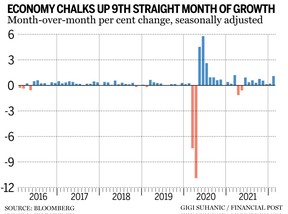Canada’s economy poised to grow in the first quarter, dodging America’s fate

Latest growth numbers just support the case for larger Bank of Canada hike

Article content
Canada will face growing economic headwinds with considerable momentum.
Advertisement 2
Story continues below
Article content
Statistics Canada reported April 29 that gross domestic product grew 1.1 per cent in February, and the agency estimated the economy likely expanded 0.5 per cent in March, suggesting Canada pushed through the Omicron wave with relative ease.
That wasn’t a given at the end of last year. Many assumed strict health restrictions in Ontario and Quebec over the winter months would kill economic activity, as they had at previous times during the pandemic. The Bank of Canada citied uncertainty over COVID-19 as one of the reasons it opted against raising interest rates in January, even though inflation had surged well above the high end of its comfort zone.
Now, the strength of Canada’s economy is giving the central bank reason to accelerate interest-rate increases. Policymakers said earlier this month that GDP likely expanded at an annual rate of three per cent in the first quarter, compared with a January estimate of two per cent. Statistics Canada’s monthly tallies of economic output are calculated differently than its quarterly assessments, but the former generally aligns with the latter. GDP grew about 0.5 per cent from December to January, suggesting the quarterly rate of growth will exceed five per cent, economists said.
Advertisement 3
Story continues below
Article content
“Today’s GDP report reinforces the view that the momentum in Canada’s economy is unrelenting,” Toronto-Dominion Bank’s James Orlando said in a note. “Compared to our neighbour to the south and our global peers, Canada is clearly outperforming.”

Indeed, the first of three estimates of U.S. first-quarter growth by the Commerce Department this week showed the world’s largest economy shrank at an annual rate of 1.4 per cent, surprising most Wall Street forecasters, who were expecting an increase. Canadian bond yields rose after the Canadian numbers were released, suggesting investors anticipate evidence of stronger growth will keep pressure on the Bank of Canada to raise its benchmark rate at a relatively aggressive pace as it tries to catch up to inflation.
Advertisement 4
Story continues below
Article content
“Pressure continues to build for the Bank of Canada to ease off the monetary policy accelerator more rapidly,” Claire Fan, an economist at Royal Bank fo Canada, advised her clients, adding that a second consecutive half-point increase is “looking increasingly likely” at the central bank’s next policy announcement on June 1.
GDP got a lift from predictable sources. Restaurants and hotels led the way, as the lifting of health restrictions led to a 15-per-cent increase in output by the food and accommodation industry, Statistics Canada said. Oil producer and miners posted a 3.4-per-cent gain, the biggest since the end of 2020, as companies benefited from increased demand and higher prices. Construction and “computer systems design,” a proxy for the digital technology industry, also posted notable increases.
Advertisement 5
Story continues below
Article content
The surprising momentum could be tested in the months ahead, as a growing number of signals suggest global inflation, ongoing supply disruptions, and uncertainty over the war in Ukraine could slow the recovery from the COVID recession. Amazon.com Inc. said April 28 that it had downgraded its outlook amid rising costs and weaker demand for the goods it sells online. And Macklem indicated in parliamentary testimony this week that he’s wary of what recent COVID lockdowns in China portend for global growth and supply-side inflation.
Indeed, it isn’t difficult to find economists who think Canada and other big economies are setting up for another recession. But such speculation won’t stop the Bank of Canada from raising interest rates in the short term, as Macklem told lawmakers that he and his deputies will be considering another half-point increase when they next gather to decide on the setting for the benchmark rate.
“The Canadian economy is in good shape,” Macklem told the House finance committee on April 25. “It can handle higher interest rates. It needs higher interest rates.”
• Email: [email protected] | Twitter: carmichaelkevin
_____________________________________________________________
We’re introducing FP Answers, a new initiative at the Financial Post where readers ask the questions and we find the answers. Ask your question today
_____________________________________________________________
Advertisement
Story continues below





